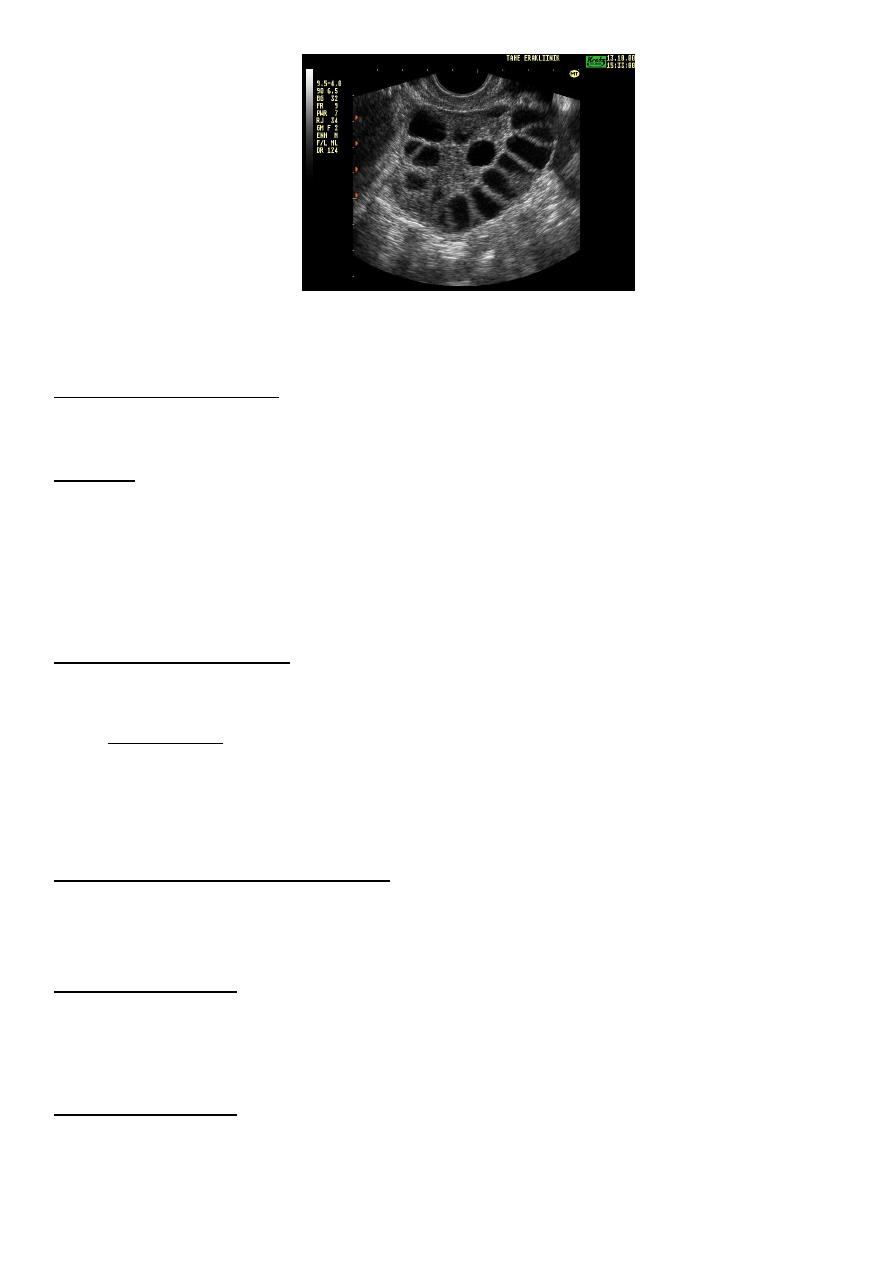
1
Fifth stage
Gynecology
Lec-4
د.أسماء
01/10/2016
Polycystic Ovary Syndrome
Objectives:
The student at the end of this lecture should be able to:
Enumerate the diagnostic criteria for PCOS.
Describe it’s clinical presentation.
Describe the underlying hormonal changes .
Describe the ultrasounic features diagnosing PCOS.
Predict the life long risk for PCOS.
Differentiate PCO from PCOS.
Describe the available options for treating the presenting problems.
Poly cystic ovary syndrome:
Is a chronic heterogeneous collection of symptoms and signs,
About 6-10% of women of reproductive age has some features of PCOS.
Its onset starts at the time of puberty.
It’s the commonest endocrine disorder in women,
It's diagnosed by the presence of two out of the following three criteria:
1. oligo and /or anovulation.
2. Hyperandrogenism clinically or biochemically.
3. Polycystic ovaries by transvaginal ultrasound.
Diagnosis of PCOS is controversial and by exclusion.
Inheritance:
There is inheritable aspect of PCOS, it runs in
Families and affect approximately 50% of 1
st
Degree relatives suggest dominant inheritance

2
Clinical presentations of PCOS
1. No symptoms
2. Menstrual irregularities and dysfunction :
(90%) ranging from oligomenorrhoea to amenorrhoea ,
About 30% have normal cycle,50%have oligomenorrhoea and 20% have amenorrhoea.
Even in patient with regular cycle with hyperandrogenism the rate of anovulation is
21%.
3. Hyperandrogenism : hirsutism (90%) is the commonest presentation of PCOS,with acne
,alopecia ,but not virilism.
4. Infertility in about (75%)
5. Obesity (60%): central type with higher waist to hip ratio .
6. Recurrent miscarrige:its relation to PCOS has been recently questioned.
7. Insulin resistance and hyperinsulinemia .
8. Impaired glucose tolerance test (1/3 of obese PCOS patient have impaired glucose
tolerance test and 7.5% to 10% have type 2 diabetes.
9. Abnormal lipoprotein are common in PCOS (elevated total cholesterol, triglyceride, LDL,
and low level of HDL.
Pathophysiology and laboratory finding:
Hyperandrogenism and anovulation in PCOS is caused by endocrine abnormality mainly in
the ovary with the total testosterone level is usually not more than twice the upper normal
range.
High intra-ovarian androgen concentration inhibit follicular maturation.
the ovaries in most PCOS patients contains multiple ovarian cyst that are inactive and
arrested In the midantral stage of development,the cysts are located Peripherally in the
cortex of the ovary.
The stroma of the ovary is hyperplastic containing nests of luteinized theca cells that
produce androgen, although 20% of hormonally normal women may have Polycystic
ovaries

3
Hyperandrogenism of PCOS result from over production androgen by the ovary and
often the adrenal gland.
Patients with PCOS exhibit increased LH pulse frequency
Increase LH level, both are a result of increase GnRH
Secretion by the hypothalamus and increased pituitary sensitivity to GnRH.
The increased level of LH promotes ovarian thecal cells,leading to elevated levels of
ovarian derived androsteindione and testosterone .this leads to atresia of
developing follicles and interferes with the development of a dominant follicle or
preovulatory ovarian follicle.
Peripheral conversion of androgen to estrogen result into atonic (
abnormal)
oestrogen
level that that are higher than the normal in the early follicular phase and that
suppress FSH release from the pituitary gland.
There is disturbance in oestrogen rise and mid cycle LH surge doesn’t occurs with the
result of anovulation and progesterone production. This abnormal oestrogen fed
back result into increase LH:FSH ratio,and in 25%
There is increase in prolactin level.
Some PCOS patients have excess adrenal androgen production which is still unclear.
In 60-70% of patients insulin sensitivity is decreased leading to insuline hyper-
secretion.
This insulin hyper-secretion result into direct stimulation of thecal cells secreting
androgen.
Both high insuline and high androgen decrease hepatic production and secretion of
SHBG
.(sex Hormone Binding Globulins)
Decreased SHBG result into dramatic increase in free serum testosterone,although
the total testosterone has moderate or slight increase.
In long term insuline resistance in PCOS is associated with increased risk of metabolic
syndrome(diabetes and heart disease).
Unopposed oestrogen in women with PCOS may cause hyperplasia of the
endometrium and occasionally endometrial carcinoma.

4
Long term risk for patients with PCOS
Persistently elevated level of estrogen uninterrupted by progesterone increase the risk
of
Endometrial cancer,
Breast cancer and
Ovarian cancer.
Obesity and metabolic abnormality and increase of plasminogen activator inhibitor
cause reduced fibrinolysis all are risk factors for the development of
Ischemic heart disease (7 fold increase in MI) ,
hypertension and
Dyslipidemia.
Insulin resistance and hyperinsulinaemia make the patient at risk of
Diabetes and gestational diabetes later on in life.
During subsequent pregnancy there is increased risk of
Abortion,
Gestational diabetes ,
And pre-eclampsia.
There is also increased morbidity in obese PCOS who fails to reduce their weight.
Diagnostic investigation
Ultrasound :(
trans-vaginal
)
increased stromal thickness and increased ovarian volume (>10 cm3)
(Specific for PCOS), and the presence of 12 or more follicles measured 2-9 mm in diameter.
Serum endocrinology:
Increase serum LH
Increase serum LH: FSH ratio
Increase serum androgen (testosterone and androstenedione)
Decrease SHBG
Increase estradiol and estrone (not measured routinely as Very wide range of values).
Increase serum prolactin.
Increase serum insulin level.
Impaired glucose tolerance.

5
Management of PCOS:
The clinical management of PCOS should be focused on the individual problems
Obesity:
Obesity worsen the symptoms and the endocrine profile so obese women (BMI >30 kg/m2)
should reduce their weight and modify their life style by diet modification , increase
exercise , stop smoking.
Menstrual irregularities:
Low dose combined oral contraceptive preparation.
Progesterone as medroxy progesterone
Acetate (provera) Or dydrogesterone
(duphastone) for 12 days every 1-3 months to induce withdrawal bleeding.
Hyperandrogenism and hirsutism :
A standirized scoring system as the modified Ferriman and Gallway score may be used to
evaluate the degree of hirsutism before and during treatment .
Physical treatment
:
Electrolysis, waxing and bleaching, Laser and photothermolysis may be helpful while
Waiting the effect of medical treatment.
Medical treatment
: stop further progression and decrease the rate of hair growth.
Adequate contraception is important during treatment as antiandrogen disturb the
development of male genital tract:

6
First line is DIANTTE (ethinylestradiol 30 Mg with cyproterone acetate 2mg.CPA may
cause liver damage
So require regular checking and once response is achieved we should be switched to
COCP because dianette can increase the risk of thromboembolism.
Spironolactone is a weak diuretic with antiandrogenic properities can be used when
COCP is contraindicated
At a daily dose of 25-100 mg .
Other antiandrogen as Ketoconazole ,Finasteride and Flutamide (not used because their
side effect and they are no more effective than CPA
Treatment of infertility in PCOS
1. Life style modification including diet reduction and exercise. A loss of 5-10% of body
weight in obese PCOS patients improve the prospect of both spontaneous and drug induced
ovulation
2.Medical Induction of ovulation in PCOS patient
by:
A. .antioestrogen : - clomifene citrate .
- Tamoxifene.
Clomifene citrate :
is an orally active synthetic non steroidal compound with oestrogenic and non
oestrogenic properties.
It displace the oestrogen from it’s receptor at the hypo- thalamic pituitary axis reduce it’s
negative feedback and encourage GnRH secretion.
It’s administered at 50 mg daily dose on day 2-6 of a spontaneous and induced menstrual
cycle(increased by 50 mg /day till ovulation occur for a max. Dose. A course of 6-12 cycles
can be used in women who respond to treatment with monitoring by ultrasound for
follicular response. Ovulation is expected in 80% and pregnancy in 40% .
Adverse reaction to such treatment
:
-Antioestrogenic side effect including thickening of the cervical mucos and hot flushes in
10% of women.
-abdominal pain ,nausea , vomiting .
-headache and visual disturbance.
-breast tenderness.
-reversible hair loss.

7
-ovarian enlargement, and ovarian hyperstimulation syndrome is rare in <1%.
-Multiple pregnancy in 10%.
-Ovarian cancer described in women receive treatment for more than 12 cycles.
Tamoxifen:
has structure similar to clomifene .the recommended dose is 20- 40 mg per day from day 3
for 5 days it have the same pregnancy rate as clomifene with less potent antioestrogenic
action on the cervical mucos.
B. Medical induction by gonadotrophin :
Gonadotrophin are used when the patient do not respond to clomifene or fails to
conceive after 6-12 ovulatory cycles.
Preperation in common use include recombinant FSH or purified urinary human
menopausal gonadotrophin (FSHand LH).
Gonadotrophin treatment result in cumulative Pregnancy rates of 40-50% and 1-2%
rate of OHSS.
C. GnRH analogues in ovulation induction : it’s used in conjunction with gonadotrophin to
achieve pituitary down regulation to facilitate cycle control
D. . Metformin :
This is an oral biguanide inhibits the production of hepatic glucose ,enhance the
sensitivity of peripheral tissue to insulin thus decrease the secretion of insulin and
treat hyperinsulinaemia.
Metformin is shown to decrease hyperandrogenism and abnormalities of
gonadotrophin secretion and can restore menstrual cyclicity and fertility.
The usual dose is 850 mg bid or 500 mg t.d.s. taking before the meal .
Side effect of metformin: nausea ,vomiting , flatulance and diarrhoea . (these can be
reduced by taking the drug before the meal and by gradually increasing the dose
start with 850 mg nocturnal then 850 mg bid for the next week.
Metformin is not usually cause Lactic acidosis in non-diabetic patient with PCOS with
normal liver and renal Function
Regular checking of renal and liver function, metformin should discontinued for 3
days after iodine containing compound and should be discontinued during pregnancy
(although there is no evidence of teratogenesis.

8
3. Surgical method of ovulation induction
Laparoscopic ovarian diathermy LOD: by diathermy or Laser, it appear to be more
successful in a slim patient with high LH level. A unipolar coagulating current is used to
deliver four punctures to a depth of 4 mm in each ovary .The principle advantage of ovarian
drilling is monofollicular ovulation resulting in fewer multiple pregnancy rate with the
cumulative pregnancy rate similar to those obtained with 3-6 cycle of gonadotrophin.
LOD has replaces the wedge resection of the ovaries as it result into extensive peri-ovarian
and peritubal adhesion.
Hair-IN syndrome
:
is an inherited hyperandrogenic disorder of sever insuline resistance distinct from
PCOS,with this high insuline is mitogenic to the basal layer of the epidermal cells leading to
the development of acanthosis nigrigans, a velvety hyperpigmented change of the crease
areas of the skin, insline affect the ovaries become hyperthcotic (ovarian hyperthecosis).
Patients may be severely hyperandrogenic and even present with virilism,there is increased
risk of dyslipidaemia,type 2 diabetes mellitus,hypertention and cardiovascular disease.
These patients are difficult to treat ,although the use of long acting GnRH has been
promising.
A.L.Y
